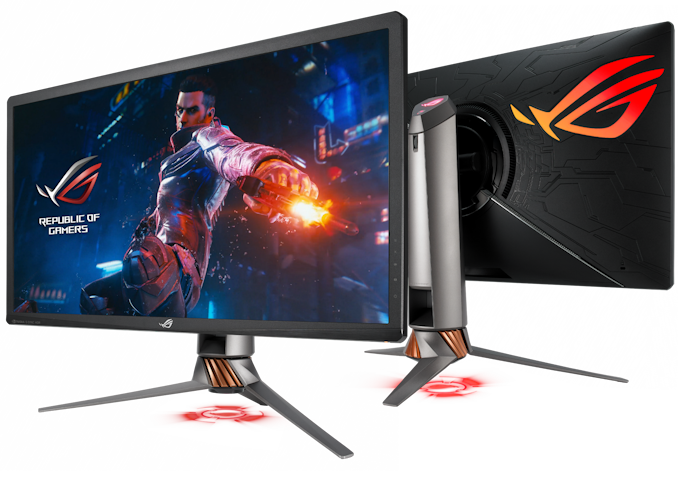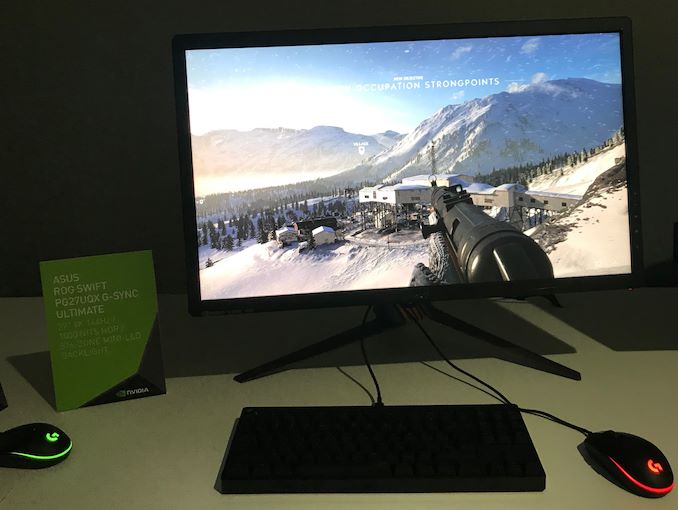NVIDIA G-Sync Ultimate Mini LED Monitors: From Acer & ASUS Later in 2019
by Anton Shilov on June 18, 2019 3:15 PM EST- Posted in
- Displays
- Acer
- Asus
- Trade Shows
- NVIDIA
- G-Sync
- G-Sync HDR
- Computex 2019

Known for its ability to build ecosystems around its products, NVIDIA rolled out a updated display-related initiative at this year’s Computex trade show. With the recent advent of commercial-scale miniaturized LEDs (Mini LEDs), NVIDIA and its partners are putting together a new generation of G-Sync Ultimate (HDR) monitors incorporating the smaller LEDs for use as backlighting. Similar to 2018's first-generation G-Sync Ultimate monitors, NVIDIA is working with Acer and ASUS on the monitors, which will pair a Mini LED-based (and quantum dot enhanced) backlighting system with 144 Hz IPS LCD panels. These 4K 27-inch LCDs are looking to iterate on previous designs by offering an even greater number of LED backlighting zones, further improving the monitors' contrast and reducing the remaining backlight bloom.
Monitors based on the company’s Mini LED reference design will initially be available from Acer and ASUS. These 27-inch displays will feature a 576-zone Mini LED-based backlighting system, which is a 50% increase in zones over the first-generation 384-zone designs. And, like their predecessors, these new monitors will incorporate Full Array Local Dimming (FALD) for fine-grained backlighting control and improved contrast, and a quantum dot film layer for wide color reproduction. Specific color gamut coverage levels haven't been announced, but NVIDIA has confirmed that these monitors will peak at 1000 nits brightness (in HDR mode), the same as the earlier monitors. Past that, we're looking at the same general specs as the first-gen displays, with a 3840x2160 resolution panel that can go up to 144 Hz.
The big question, of course, is pricing and availability. While NVIDIA is only responsible for the reference design and, officially at least, is deferring to Acer and ASUS on retail details, the company is all but promising that the Mini LED-based monitors will reach store shelves this year. As for pricing, that remains to be seen. The first-generation monitors already carried a hefty price tag of around $2000, and while this is a premium market, even higher price tags for the Mini LED Predator and ROG Swift PG27UQX may be hard to swallow. So hopefully Acer and ASUS are able to get these monitors on to the market at the same point where the first-generation monitors will leave off.
Related Reading:
Source: NVIDIA












32 Comments
View All Comments
nathanddrews - Tuesday, June 18, 2019 - link
Unless these also use dual-layer LCD, I'm worried that the contrast will still struggle. However, as a MicroLED stopgap goes, it could be nice.mukiex - Tuesday, June 18, 2019 - link
Maaaan, dual-layer LCD would be awesome. How come we haven't seen anything on that since the HiSense demo in January?TheWereCat - Tuesday, June 18, 2019 - link
Wouldn't the brightness be an issue then?edzieba - Tuesday, June 18, 2019 - link
Because dual-panel costs far more than FALD, has absurd power consumption (the Dulby Vision concept display has a WATER COOLED backlight to avoid cooking the panels!), and poor black levels without using a FALD backlight anyway.PeachNCream - Tuesday, June 18, 2019 - link
I was under the impression that NVIDIA was transitioning to supporting FreeSync or something with their newer GPUs. Why G-Sync anything now if that's about to be abandoned?0siris - Tuesday, June 18, 2019 - link
As I understand it, there will still be G-sync monitors which will have that branding and the physical G-sync module in the monitor along with meeting certain standards Nvidia sets and tests the monitor for. Then there are also various FreeSync monitors without the G-sync module which Nvidia tests and then qualifies as "G-sync compatible" - basically stating that the VRR experience is good enough for their standards, even if it isn't actually a G-sync monitor. Then there's also G-sync ultimate, which has to do with 1000+ nits HDR or something.Hxx - Tuesday, June 18, 2019 - link
if you know nvidia, then u know they are always trying to be on the forefront. everything out there except the latest LG panels uses gen 1. they needed a refresh badly but didnt want to miss out on those first gen high refresh displays and gpu sales so they started this gsync compatible stopgap. Once they roll out gsync gen 2 or whatever is called premium, thats gonna be their focus and not so much gsynci compatible displaysRyan Smith - Tuesday, June 18, 2019 - link
NVIDIA added support for VESA Adaptive Sync monitors. However they are not dropping G-Sync, particularly at the high-end since there's no equivalent VESA standard for all of the different requirements NVIDIA has for G-Sync Ultimate HDR monitors (brightness, color space, GtG, refresh rate, etc).halcyon - Wednesday, June 19, 2019 - link
No, nVidia just added software / driver level support for VESA AdaptiveSync monitors so that you can use them in GSync Compatible (with artifacts and all w/ most AdaptiveSync monitors) mode with your nVidia GPU.If you want:
- guaranteed low latency
- ULMB
- wider refresh rate range guaranteed
- HDR with G-Sync enabled (incl. lower latency, wide colour space, minimum contrast, brightness, etc)
Then you need to shell out money for a hardware module based nVidia GSync (or Gsync HDR aka GSync Ultimate) certified monitor. Not just a GSync compatible monitor (which has no Gsync lab testing and hardware module inside).
BurntMyBacon - Thursday, June 20, 2019 - link
@halcyonTo be fair, aside from the GSync hardware module, there is nothing stopping a (non-GSync) VESA Adaptive Sync monitor from supporting any or all of the requisite features offer by the higher end nVidia certifications. In fact, there are FreeSync monitors available that have some of the features you listed. However, you would need to verify it all yourself. The nVidia certification makes things much easier. I'm relatively happy with the GSync program in its current form and wish it had evolved to this point much earlier.